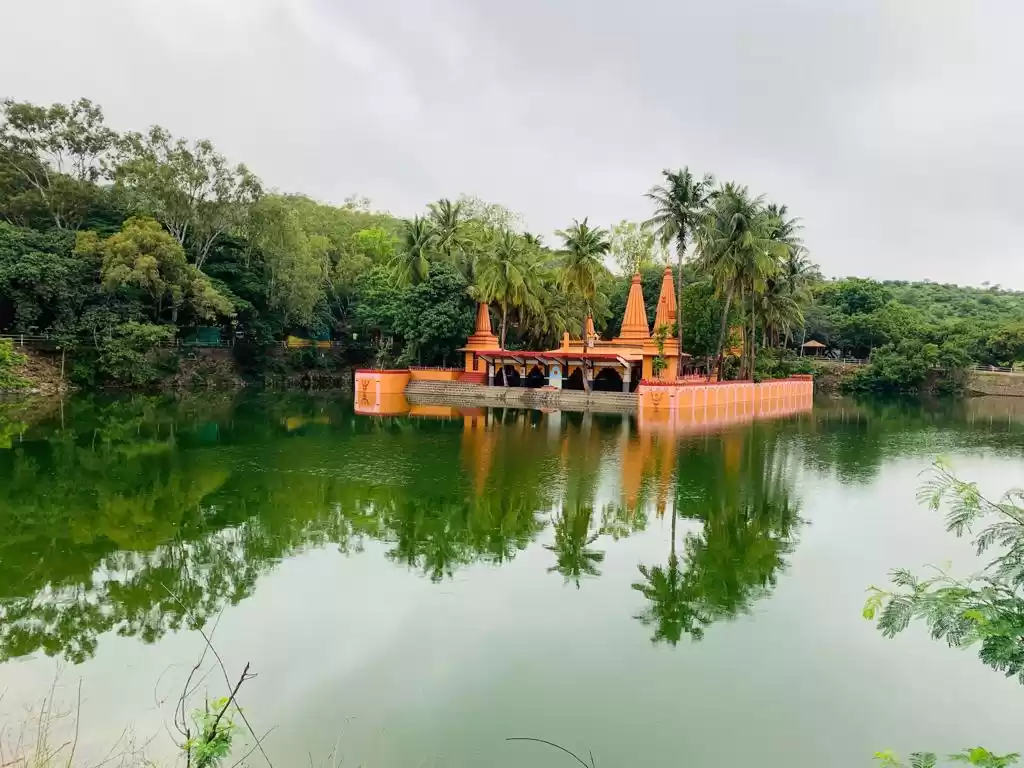Maharashtra, a state rich in culture and spirituality, is home to the famous Ashtavinayak temples—eight sacred shrines dedicated to Lord Ganesha, each with its own divine legend. Among them, the Ozar Ganpati Temple, also known as Vighnahar Ganpati Temple, stands as a beacon of peace, power, and devotion. Located in the serene village of Ozar in Junnar taluka of Pune district, this temple is renowned for its unique history and religious significance. Lord Ganesha is honored here as Vighnahar, symbolizing the power to overcome all challenges.
This article explores the mythology, history, architecture, rituals, and spiritual significance of the Ozar Ganpati Temple.
1. Ashtavinayak Yatra: The Spiritual Context
Ashtavinayak refers to eight sacred Ganesha temples located across Maharashtra. Devotees undertake this sacred pilgrimage in a specific order, starting and ending at the Moreshwar Temple in Morgaon. Each temple is associated with a specific legend that contributes to Lord Ganesha’s divine status in Hindu mythology.
The Ozar Ganpati Temple holds the seventh place in the Ashtavinayak Yatra and is particularly revered as the Vighnahar, meaning “destroyer of obstacles.” It is the only temple among the eight where Ganesha is depicted as a warrior who defeated a powerful demon
2. The Mythological Legend of Vighnasura
The tale of Ozar’s Ganesha comes from the Bhavishya Purana and age-old oral traditions.
According to legend, King Abhinandana was once performing a grand yajna (sacrificial ritual) without offering it to Lord Indra, the king of the heavens. Angered by this slight, Indra sent a powerful demon named Vighnasura to disrupt the ceremony.
Vighnasura began causing havoc across the world, destroying rituals, disturbing sages, and spreading fear. Seeking relief, the gods and sages turned to Lord Ganesha, the deity of wisdom and remover of obstacles.
In a fierce battle, Lord Ganesha subdued Vighnasura. The demon, realizing his folly, repented and surrendered. He requested Ganesha to forgive him and promised never to trouble anyone performing righteous deeds. Moved by his remorse, Ganesha granted him mercy and declared that those who worship Him as Vighnahar at this holy site would be free from obstacles in life.
And so, Ozar Ganpati Temple became known as the sacred site where Lord Ganesha defeated Vighnasura and took the name Vighnahar.
3. Historical Origins of Ozar Ganpati Temple
The exact date of the temple’s construction is unclear, but it is believed to be several centuries old. The temple as seen today was rebuilt and renovated by the Peshwa General Chimaji Appa (brother of Baji Rao I) in the 18th century.
Following his 1739 victory over the Portuguese at Vasai (Bassein Fort), Chimaji Appa gifted church bells to several temples, including Ozar. These bells still exist today and are considered an important historical artifact.
The temple has seen multiple phases of restoration and enhancement through the centuries, with contributions from local rulers, devotees, and trustees. Despite the changes, the temple’s sanctity and traditional spirit remain intact.
4. Ozar Ganpati Temple Architecture
The Ozar Ganpati Temple is known for its elegant Peshwa-style architecture. The temple complex is well-maintained and exudes a sense of peace and divinity. Key architectural highlights include:
- Grand Entrance (Mahadwar): Beautifully carved with intricate designs, it warmly welcomes devotees.
- Deepmal (Lamp Tower): A traditional structure that is beautifully lit during festivals.
- Sabha Mandap (Assembly Hall): Spacious and supported by finely carved stone pillars.
- Sanctum Sanctorum (Garbhagriha): Houses the main idol of Lord Vighnahar Ganpati, decorated with gold ornaments and adorned with a serene expression.
- Stone Elephant Statues: Placed near the main entrance, symbolizing strength and protection.
The temple is also built in such a way that it faces east, allowing the first rays of the sun to fall on the idol—a typical feature of ancient Indian temple design.
5. The Idol of Vighnahar Ganpati
The idol of Lord Ganesha at Ozar is swayambhu (self-manifested), and it is considered jagrut (alive or awakened). The murti (idol) is:
- About 3 feet tall and 2.5 feet wide.
- Flanked by his consorts Riddhi and Siddhi, symbolizing prosperity and spiritual power.
- Adorned with a diamond-studded forehead and a magnificent gold-plated crown.
- Seated in a lotus posture with His trunk turned to the left, which is considered more peaceful and auspicious.
The idol exudes a calm yet powerful presence, believed to protect devotees from hurdles and grant their sincere wishes.
6. Rituals and Celebrations
The temple follows a daily schedule of rituals such as Kakad Aarti, Abhishek, Naivedya, midday Aarti, and Shej Aarti. On special days, elaborate poojas and havans are conducted.
Important Festivals Celebrated:
- Ganesh Chaturthi: A vibrant 10-day festival marked by processions and cultural festivities.
- Ganesh Jayanti: Celebrated in Magha month, marking the birth of Lord Ganesha.
- Bhadrapad Utsav: Huge crowds visit the temple, and special decorations and rituals are performed.
During these times, the temple is beautifully lit, and the atmosphere is filled with devotion, music, and community bonding.
7. How to Reach Ozar Ganpati Temple
Located about 85 km from Pune and 180 km from Mumbai, Ozar is well connected by road.
By Road:
- Pune to Ozar via Narayangaon takes approximately 2.5 to 3 hours.
- Regular MSRTC buses and private cabs are available.
By Rail:
- Nearest railway station: Pune Junction or Nashik Road.
- From there, you can hire a cab or board a bus to Ozar.
By Air:
- Nearest airport: Pune International Airport (90 km).
8. Ozar Ganpati Temple Timings
- Morning Aarti: 5:00 AM
- Temple Opening Time: 4:00 AM to 9:00 PM (Open all days)
- Special Days: Open till midnight during festivals.
Note: It’s best to visit during the early morning hours or after 4 PM to avoid peak crowds and harsh sunlight.
9. Best Time to Visit Ozar Ganpati Temple
Though the temple welcomes visitors all year, the ideal time to visit is:
- Monsoon Season (June–September): Lush green surroundings and pleasant weather.
- Festivals: Ganesh Chaturthi and Ganesh Jayanti bring vibrant and grand festivities.
- Winter Months (October–February): Ideal climate for a spiritual trip and Ashtavinayak Yatra.
10. Nearby Attractions
Combine your visit to Ozar with these nearby spiritual and scenic destinations:
- Lenyadri Ganpati Temple (Girijatmaj): An Ashtavinayak shrine set within a Buddhist cave, just 15 km from Ozar.
- Shivneri Fort: Birthplace of Chhatrapati Shivaji Maharaj, about 20 km from Ozar.
- Junnar Caves: A network of ancient Buddhist caves, perfect for history lovers.
- Naneghat: A scenic mountain pass ideal for trekking.
11. Importance for Devotees and Pilgrims
Ozar Ganpati is not just a place of worship—it is a symbol of spiritual victory over challenges. Devotees often visit this temple when starting a new business, taking exams, undergoing surgeries, or stepping into a new phase of life. The belief in the power of Vighnahar is so strong that people return here year after year with gratitude.
Many pilgrims consider it essential to visit all eight Ashtavinayak temples in one trip to complete the yatra and attain the Lord’s full blessings. Ozar, with its vibrant atmosphere, historical significance, and mythological depth, is often considered one of the most powerful among the eight
Conclusion
Ozar Ganpati Temple, devoted to Lord Vighnahar, is not just a temple but a confluence of mythology, devotion, and history. The legend of Vighnasura, the architectural beauty of the temple, and its vibrant festivals make Ozar a spiritually uplifting destination for every devotee.
Whether you are embarking on the Ashtavinayak Yatra, seeking blessings to remove life’s obstacles, or simply looking to experience divine serenity, Ozar Ganpati Temple promises peace, power, and fulfillment. Visit this holy shrine and let the remover of obstacles guide your path with wisdom and grace.
Frequently Asked Questions
Q1: What is the significance of the Ganpati Temple Ozar?
Ans: Ganpati Temple Ozar, or Vighnahar Ganpati, is one of Maharashtra’s eight Ashtavinayak temples, dedicated to Lord Ganesha as the remover of obstacles.
Q2: What is the Ozar Ganpati temple’s history?
Ans: The temple was rebuilt in the 18th century by Chimaji Appa after his victory over the Portuguese, as an offering to Lord Ganesha.
Q3: What makes the Ozar Ganpati temple architecture unique?
Ans: The temple features Hemadpanti-style architecture with a golden dome, lamp towers, and a spacious courtyard. The idol faces east with a left-turned trunk and is adorned with ornaments.
Q4: What is the Ozar Ganpati temple story?
Ans: Lord Ganesha defeated the demon Vighnasura, who then vowed never to cause obstacles again. Ganesha took the name Vighnahar and resided at Ozar.
Q5: Which are the Ashtavinayak temples in Maharashtra?
Ans: The eight temples are: Mahaganapati at Ranjangaon, Mayureshwar at Morgaon, Siddhivinayak at Siddhatek, Ballaleshwar at Pali, Varad Vinayak at Mahad, Vighnahar at Ozar, Girijatmaj at Lenyadri, Chintamani at Theur, and Mahaganapati at Ranjangaon
Q6: How to reach Ozar Ganpati temple?
Ans: Ozar is 85 km from Pune and 160 km from Mumbai. The nearest railway station is Pune, and Pune Airport is the closest airport. You can drive or take state transport buses, or cabs from Pune and Junnar.
Q7: What are the Ozar Ganpati temple timings?
Ans: The temple is open from 5:00 AM to 10:00 PM. Kakad Aarti in the early morning and Maha Aarti in the evening are highly recommended for devotees.
Q8: What is the best time to visit Ozar Ganpati?
Ans: October to March is ideal for pleasant weather. Monsoon season (July-September) offers lush surroundings, while festivals like Ganesh Chaturthi and Maghi Ganesh Jayanti attract large crowds.
Q9: Can I take Ozar Ganpati temple photos?
Ans: Photography is allowed in most areas except the sanctum. Devotees often capture the golden dome, lamp towers, and beautifully decorated idol during festivals.
Q10: Is the Ozar Ganpati temple near Junnar?
Ans: Yes, Ozar is located in Junnar Taluka, Pune district, and is close to Lenyadri caves and Shivneri Fort, making it a perfect spiritual and historical getaway.
Q11: What about Ozar Ganpati accommodation options?
Ans: Accommodation is available at Temple Trust guesthouses, budget hotels in Ozar and Junnar, and nearby resorts or farm stays. Advance booking is recommended during festivals.
Q12: Is there an Ozar Ganpati temple?
Ans: Yes, the temple offers ample parking space near the entrance for both two-wheelers and cars, along with facilities like clean washrooms, drinking water, and cloakrooms.
Q13: What is the Ozar Ganpati temple in Pune?
Ans: The temple is approximately 85 km from Pune, and the drive takes about 2 to 2.5 hours via NH60.
Q14: What are the nearby attractions?
Ans: Lenyadri Temple, Shivneri Fort, Junnar Caves, Naneghat.
Q15: What is the Ozar Ganpati darshan guide?
Ans: Arrive early on weekends, attend Kakad Aarti, and enjoy prasad offerings like modaks. During festivals, special passes may be available for quicker darshan.



